![]()
Sun, Januari 23, 2011 | The Meir Amit Intelligence and Terrorism Information Center
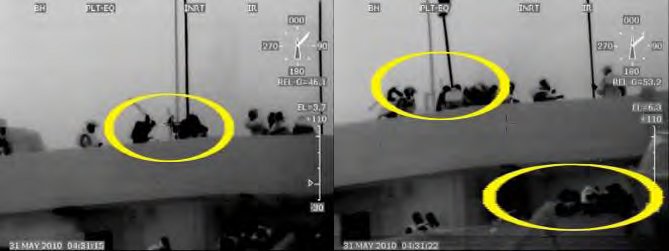
Left and top right: Operatives beat IDF soldiers as soon as they land on deck. Bottom right: The first soldier off the helicopter is beaten after having been thrown to the lower deck (Photographed by the Israeli Navy).
Testimonies from IDF Naval Commandos Who Participated in the Raid on the Mavi Marmara
Detailed testimony from IDF officers and soldiers, supported by documentation, reveals for the first time the aggressive, brutal fighting carried out by IHH operatives and their accomplices against Israeli forces aboard the Mavi Marmara.
Overview
This report describes the fighting waged by IHH operatives and their accomplices against IDF soldiers aboard the Mavi Marmara. The descriptions are based on testimonies given by IDF officers and soldiers who participated in the takeover of the ship (names withheld by the IDF).
The testimonies corroborate the vast amounts of information gathered by the ITIC since the takeover of the Mavi Marmara (some of which, including visual material, was used in this report to complete or illustrate the IDF soldiers’ testimonies). The information includes photographs and videos taken aboard the Mavi Marmara by the IDF as well as journalists who accompanied the flotilla and foreign media; documents seized aboard the ship; statements made by passengers; descriptions in The Bloodstained Mavi Marmara, the book about the flotilla written by Turkish journalist Şefik Dinç published in Turkey; and information appearing in the Turkish and Western media (including the BBC’s “Panorama”).
The testimonies of the IDF soldiers, supported by ITIC information, unequivocally refute the false, biased claims made by the operatives aboard the Mavi Marmara, claims which were used in the report criticizing Israel lodged with the factfinding mission sent by the Human Rights Council in Geneva. The main conclusions drawn from the testimonies are the following:
1) The IDF force which took over the Mavi Marmara was faced with organized resistance from scores of operatives (IHH operatives and their accomplices). They were highly motivated and armed with knives, clubs, axes, iron chains, etc. They had been equipped with bulletproof vests, gas masks, pepper spray, headlamps and walkie-talkies. Their mode of deployment and modus operandi indicate that at least some of them had military skills (early briefing, centralized direction, assignment to fighting stations, professional knowhow for operating military equipment and weapons, combat tactics, etc.).
2) The claims that guns were fired from the IDF helicopter at the deck of the Mavi Marmara, that the IDF forces fired their weapons indiscriminately, and that they shot at passengers point-blank are false. At no time did the soldiers shoot from the helicopters, and the helicopters were not equipped with weapons which could be used to attack the ship. According to testimonies from IDF soldiers and officers, a stun grenade was thrown from the first helicopter to deter the operatives (which might be the source of the claim that the helicopters fired on them).
3) Two IDF soldiers were shot a short time after they landed on the upper deck, one in the stomach, the other in the knee. According to the soldiers’ testimonies, they were shot at during the fighting. In some instances, the shots were fired from weapons snatched from IDF soldiers. The bullet wounds and testimonies of the soldiers completely contradict the Human Rights Council’s report, which denies the fact that IDF soldiers were shot.
4) During the first stages of the fighting three IDF soldiers were taken hostage, wounded and moved below decks. During their capture and confinement, despite their serious wounds they were brutally beaten with wooden clubs, stabbed and choked, genuine threats to their lives. Despite their appeals they received no medical attention. They were apparently saved by the presence of passengers not involved in the fighting and correspondents with cameras who documented their beatings, deterring their captors from killing them. Eventually, the soldiers were released when the captain used the PA system to announce that the ship was under IDF control.
5) The IDF soldiers behaved humanely toward the passengers after the operatives’ resistance had been neutralized. They tied the hands of operatives who were violent or posed a danger. Passengers whose hands were tied but not dangerous and requested to be liberated were untied. Once the situation was under IDF control, additional passengers who were not dangerous were untied whether or not they requested it. According to the testimonies, including the statement made by a doctor aboard the Mavi Marmara, the wounded were treated professionally and with care, even some who refused medical treatment and evacuation to Israel, claiming they wanted to die as shaheeds. Despite the difficult circumstances under which the Israeli medical team worked, not one single wounded operative died.
Deployment for Battle of IHH Operatives and Their Accomplices
Testimonies from the IDF forces indicate that scores of operatives armed with knives, axes, iron chains, clubs and possibly live weapons participated in the fighting (completely contradicting the claims made by IHH leader Bülent Yildirim during the sea voyage that “we do not have so much as a penknife”). According to the testimonies of the IDF soldiers, they found themselves confronted by scores of well-trained operatives who behaved totally differently from the ordinary passengers, who did not take part in the fighting. Those operatives followed an organized, centrally directed plan, were equipped with weapons and other military equipment to harm IDF soldiers and prevent them from boarding the ship at any cost.

Left: As soon as the soldiers boarded the ship the operatives completed their preparations. They put on bulletproof vests and gas masks and began confronting the soldiers with iron bars and wooden clubs (Picture and caption from Şefik Dinç's book). Right: Operatives hold clubs in preparation for a confrontation. In the center rolled-up clubs can be seen, waiting to be unrolled and distributed.
According to the testimonies of the IDF soldiers, the operatives who were deployed for battle were wearing bulletproof vests and were equipped with gas masks, pepper spray, headlamps and walkie-talkies. They had printouts of instructions and code words to be used when IDF soldiers boarded the ship.

Left: Operatives armed with improvised clubs made from the ship's railings wait below decks (Photo by Adem Ozkose for Reuters, May 31, 2010). Right: An operative holds a club made from the ship's railing (YouTube).
According to the testimonies of IDF soldiers who boarded the Mavi Marmara, the deployment and tactics used by operatives during the takeover of the ship indicated that they had military qualifications. Indications included pre-confrontation briefings, assignment to fighting positions, analysis of possible points where the IDF might board the Mavi Marmara and corresponding deployment. In addition, the fact that operatives approached the helicopters and were not deterred by the stun grenades, the way the operatives remained at the positions to which they had been assigned, the professional knowhow they demonstrated in operating hot and cold weapons and the way they fought during the IDF takeover of the ship also indicated military qualifications.
Violent Resistance to the Soldiers’ Attempt to Board the Mavi Marmara from the Sea
Before the soldiers began descending from the helicopter, the operatives aboard the Mavi Marmara exhibited violent resistance to the attempts of IDF soldiers to board the ship from naval commando boats. They threw objects at the soldiers, including iron bars, crowbars, iron chains, objects of various sizes (metal chairs, trays, glass) and a stun grenade. They also used slings to hurl objects, including pieces of metal and steel balls. To cut through the IDF’s climbing equipment they used hand-held disk saws, which had been distributed around the periphery of the upper deck.
The violent activity at the ship’s railing continued throughout the IDF takeover. Molotov cocktails ready for throwing were found near positions of operatives. During the fighting, when it became clear that the IDF was being attacked with firearms, that there were seriously wounded soldiers and that three were missing, Israeli Navy boats again approached the ship to board additional soldiers. That time as well, violent operatives were organized along the ship’s railing to throw objects at the boats, including iron bars, clubs and chains.
At that point the naval force identified a number of operatives who approached and used slings to hurl iron balls at them. Some soldiers reported a burst of gunfire targeting the boats.
Violence Directed at IDF Soldiers who Descended from the Helicopters
According to the testimonies of soldiers who were aboard the three helicopters, at first there were about 15 operatives on the upper deck. As soon as the soldiers descended from the helicopter, they were joined in a coordinated action by scores of other operatives who had been waiting nearby. According to a statement from one of the soldiers, their appearance on deck was directed by one individual.
Each IDF soldier was attacked by a team of three or four operatives. They were dragged away from the rope from which they had been lowered from the helicopter as soon as they reached the deck and attacked with both hot and cold weapons (one soldier was stabbed in the stomach and another was shot in the knee). According to the soldiers’ testimonies, the first shots were fired a short time after they began descending from the helicopter to the ship.
The IDF soldiers who reached the deck were attacked by frenzied teams of operatives carrying deadly cold weapons, including axes, knives, clubs, crowbars, metal objects hurled with slings and other objects (for example, early on one soldier was stabbed in the ear and another was repeatedly beaten and required hospitalization).
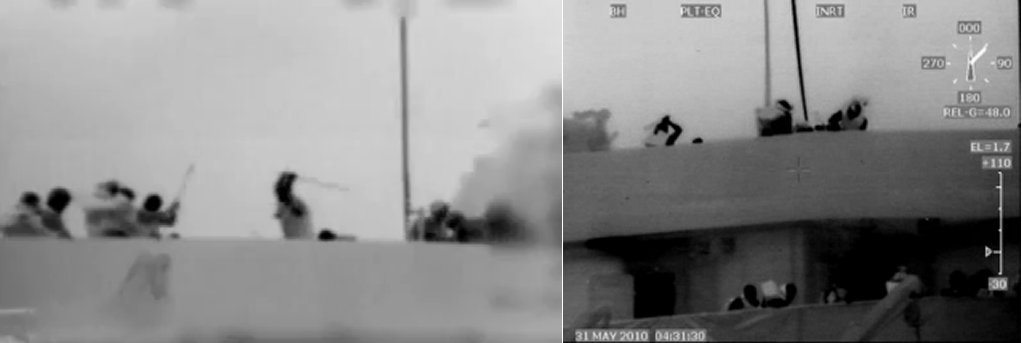
Above left and right: Operatives beat IDF soldiers as soon as they land on deck. Bottom right: The first soldier off the helicopter is beaten after having been thrown to the lower deck (Photographed by the Israeli Navy).
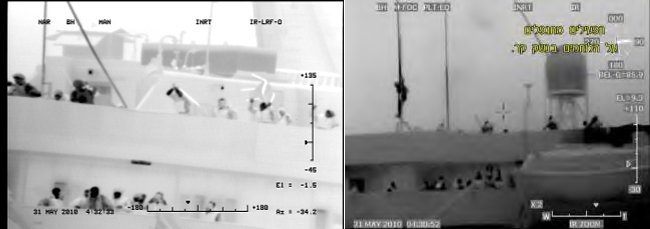
Left: Operatives on deck wait for the opportunity to beat the IDF soldiers. They are equipped with iron bars and chairs (Photographed by the Israeli Navy). Right: Operatives on deck wait for the second soldier, having already attacked the first (Photographed by the Israeli Navy).
According to one of the testimonies, “…The first minutes the battle were hard by any standard. The soldiers were fighting a life and death battle at very close quarters in an extremely limited zone. They were fighting against extremist terrorists who were ready to die, were well equipped with weapons and had had military training. [I say that because] no ordinary civilian knows how to conduct an extended fight at night wearing a bulletproof vest and a gas mask, how to take a weapon, cock it and shoot it, and not be deterred when someone is fighting against him, unless he has been trained for it and briefed beforehand…”
Capture of Three Soldiers Who Descended from the First Helicopter
The three IDF soldiers on board the first helicopter who were the first to reach the upper deck of the Mavi Marmara were brutally attacked by the operatives on deck. Their weapons were taken and they were thrown from the upper to the lower deck. They were captured in a pre-meditated, well-coordinated action carried out by a large number of operatives and brought below decks where more operatives were waiting for them.
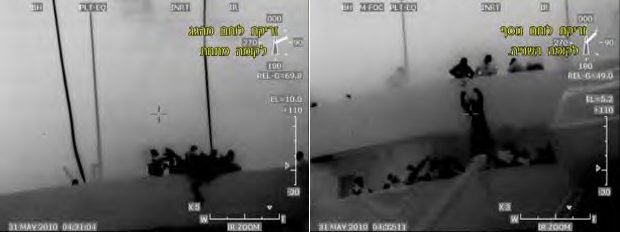
The soldiers are thrown from the upper to the lower deck by the operatives. Left: The first soldier. Right: Another soldier (Photographs taken by the Israeli Navy).
The three soldiers testified that while they were being held below decks a large number of operatives continued the attack, including choking and beating them with iron bars and wooden clubs. That was despite the fact that the hands of two were tied and the third was having convulsions and lost consciousness several times. The three were wounded and bleeding, and in need of medical treatment (one of them had been stabbed in the stomach and was critically wounded).
All three testified that during the incident their lives were in danger and they felt the operatives intended to kill them. They added that some of the passengers, those who were below decks, did not participate in the attacks and that there was a more moderate group of passengers who tried to protect them.[1] They also stated that while they were being beaten below decks they were photographed many times.[2]
After the IDF forces took over the bridge, the captain used the PA system to inform the passengers that the ship was under IDF control, and that use had been made of firearms [by the IDF]. At that point the three captive soldiers were dragged to the upper deck near the prow. As they were being dragged, the operatives continued beating and choking them. Despite their requests, the captive soldiers received no medical attention. Once above decks two of them escaped by jumping into the sea, and the third remained on deck unconscious and was later rescued by other soldiers.
According to one of the testimonies, “…The soldiers who were taken below decks were not murdered because of the 450 civilians aboard who were not accomplices to their beating, many of whom had cameras” [the murderous, violent behavior of the operatives took place outside, and the violence inside the ship was relatively slight].
The Use of Firearms against IDF Soldiers
A number of testimonies from officers and soldiers indicate that in several instances the operatives who fought the IDF forces used firearms.
The following are testimonies from the two soldiers who were shot:
1) The second soldier to descend from the helicopter and was shot in the stomach said, “…About five terrorists jumped on me and I fought them off as best I could. I was attacked with clubs, [iron] bars, metal chairs and fists. They choked me and tried to throw me into the sea from the starboard side of the Mavi Marmara…I realized that my life was in danger and that they were trying to kill me and to throw me into the water to kill me…At that point I felt a sharp blow to the left side of my stomach, and I realized that I had apparently been shot …[Note: The soldier was hospitalized in Israel and operated on. During the operation half of his lower intestine was removed, a hole in his stomach was repaired and his pancreas was found to have been damaged. He remained in the hospital for three weeks.]
2) A soldier who was one of the first to reach the upper deck was shot in the leg. He said, “…The order of descent got messed up and we didn’t go down in the original order. [I] was apparently number four or five…As soon as I hit the deck…they started hitting me with iron bars. I also saw a terrorist holding an axe. I moved four, five meters toward the stern…and a group of six, and I think more, chased me. I remember perfectly what they were holding: three had iron bars painted light blue [the color of the ship]…there were two holding knives who were running toward me and wanted to stab me, and one other had a crowbar, an iron tool about half a meter [long], one end sharp and the other end flat…
3) He continued, “…I was surrounded by five men, and one more who came a couple of seconds later…They beat me with iron bars…they hit me in the face with the bars, and on the head a lot. My head was protected by a helmet, and after the battle I was told that my helmet was completely shattered…I tried to use my hands to protect my face, so my hands got hit a lot, and one was broken [Note: One of his hands was found to have three broken bones and one cracked bone…]. Then a terrorist ran toward me with a knife and stabbed me in the chest as hard as he could…and all the time they kept beating me with iron bars. They beat my head, my stomach and my legs…I was hit on the head and the back of my neck a number of times and lost consciousness. The next thing I remember was regaining consciousness because of a severe pain in my knee…That was when I realized I had been shot in the knee. I also realized that my ear and head had been cut and that bones in my hand were broken…”
4) Question: “When the incident was over, what were your injuries?” Answer: “I was shot in the right knee, I had three fractures and a crack in my right hand, a deep cut in my left ear, internal bleeding, bruises from beating and cuts all over my body. My face was completely swollen…” Question: “In retrospect, do you know who shot you?” Answer: “As far as I know, when I was shot there were only five soldiers on board the ship. Three of them were thrown off the roof [another was shot in the stomach]…so none of the shots was fired by our forces…”
Testimony of a soldier about an operative holding a gun: “…I looked at the other side of the deck. I saw one of my comrades sitting on the deck, looking at it, his head was bleeding. There was a lot a yelling and noise everywhere. And then I looked down and I saw a handgun with a [cocking] hammer. I understood it was not one of our soldiers, because we all have handguns, and they don’t have hammers. It was close to me, just two meters away. That was when I knew they had firearms aboard ship and that they were using them to shoot at us. That was when I realized everything was different from the original plan…One of our commanders shouted that there was gunfire below [on the lower deck] and I ran with him to the port side of the hull…The commander and I kept looking for the source of the gunfire and he told me that he saw a man hiding and shooting at us…I kept guard with another soldier, and all the time someone kept looking at us from near the chimney in the stern and shooting at us sporadically…”
Question: “Did you see firearms on board the ship or firearms directed against your force?” Answer: “There was the gun I saw on the deck next to my commanding officer, who was lying there wounded. I know for certain that the handgun did not belong to us because we don’t have that kind of handgun, it had a cocked hammer and none of our guns has a hammer. I also felt gunfire coming toward us from the lower deck. It wasn’t automatic fire, just a single bullet every couple of seconds.”
Other testimonies:
1) From a soldier: “While we were searching the hall we found one of our guns with an empty magazine and the slide pulled back hidden under a couch [Note: i.e., someone had fired all the bullets…].”
2) From another soldier: “When we sailed the ship to Ashqelon we searched it. I went back to the bridge and rejoined my team. During the search we found large quantities of weapons, including iron rods, pieces of metal, wooden clubs, when all of a sudden one of the soldiers found a gun under one of the couches. It was a gun taken from one of us. The magazine was still inside but empty and the slide was back, which meant it had been fired until it was out of ammunition and then hidden.”
Treatment of the Passengers and Wounded after the IDF Takeover of the Mavi Marmara
IDF officers and soldiers testified that after the takeover of the Mavi Marmara they behaved humanely toward the passengers despite the fact that many of them refused to follow orders or cooperate. Testimonies from soldiers indicate that requests for water or to use the facilities were complied with.
Soldiers testified that they tied only the hands of operatives who caused a disturbance, or those who they were afraid might pose a danger to the IDF forces. Their testimonies indicated that passengers who did not pose a danger and who requested that their hands be untied had their requests complied with.[3] According to a high-ranking Israeli Navy officer, “Below decks the passengers sat with their hands tied. We brought them food and water and took them to use the facilities when they requested. We loosened the bindings of those who found them painful…We did not tie the hands of the women and older men…”
Medical treatment: Testimonies from officers and soldiers, including the Israeli naval commando doctor who was on board the Mavi Marmara and the unit commander for aerial evacuation, indicate that the wounded received professional medical treatment and were evacuated by air in a complex operation. They were brought to a number of locations on board the ship and with considerable effort raised to the upper deck to ensure treatment and evacuation. Triage was performed in accordance with objective medical criteria, with the result that some of the wounded IDF soldiers received treatment after wounded operatives.
According to testimony, the wounded were evacuated very rapidly. Thirty-one were evacuated in six hours, an extremely rapid rate considering that there was only one evacuation point on board the ship and that at the same time other wounded individuals were being treated. The evacuation ended around noon. An IDF doctor aboard the Mavi Marmara said that as soon as the wounded began receiving treatment not one of them died. That was despite the fact that according to testimony, several of the wounded operatives refused medical treatment, claiming they preferred to die as shaheeds.[4] In addition, according to the fleet doctor, in a number of cases wounded operatives tried to hamper medical treatment by removing and tearing off medical equipment.
According to the testimony of a high-ranking Israeli Navy officer, some of the wounded operatives were unwilling to leave the lounge below deck where they lay (apparently preferring to die rather than receive medical care from Israelis). He said that he had spoken to the doctor on board the ship, who told him that there were many wounded individuals who refused to be evacuated, some of them seriously injured. The IDF soldiers were forced to evacuate wounded operatives against their will to save their lives, while other operatives physically tried to prevent the soldiers from reaching them. Even after all the wounded had been evacuated some of the operatives continued physical resistance, and in one case the resistance was so violent the soldiers had to use force to restrain the operative.
IDF Forces Subjected to Physical and Verbal Abuse on the Flotilla’s Other Five Ships
The flotilla included five ships besides the Mavi Marmara. There were two Turkish IHH ships, the Defney and the Gazze; a European Campaign to End the Siege on Gaza (ECESG) ship, the Sfendoni 8000; the Free Gaza Movement’s Challenger; and the Sofia, a ship sent by a Greek organization which joined the flotilla. Testimonies from IDF officers who commanded the takeover of the ships indicate that the IDF forces were subjected to various levels of physical and verbal abuse and the passengers expressed readiness to use violence against the soldiers, although not at the same level exhibited on board the Mavi Marmara.
According to the testimonies of IDF soldiers, during pre-boarding exchanges of communications the soldiers told the ships that the Gaza Strip was under closure and that they would not be able to enter. The ships’ spokesmen replied that they were determined to reach Gaza and hurled invective (in English), such as “Go back to Auschwitz.”
According to various testimonies:
1) Aboard the Sfendoni 8000 the IDF forces encountered moderate violence, and even beyond: for example, an attempt at evasion was made which endangered other IDF vessels in the zone; objects were thrown when vessels were approached; an attempt was made to take a soldier’s weapon; the soldiers were shoved down a ladder to the lower deck and dozens of passengers engaged in physical violence at close quarters. The passengers also attempted to congregate on the roof. [Note: According to testimony from a soldier regarding the Sfendoni 8000, “…One of the boats [the Sfendoni 8000] maneuvered itself very close to us, it was on a collision course. That is, it simply tried to run us down, and chased us even after we tried to evade it. It got as close as 20 meters, a very short distance in naval maneuvering, and it presented a clear and immediate danger to our vessel…Finally we made a sharp turn and got in back of it…”]
The Sfendoni 8000, the ECESG ship which participated in the flotilla. Its name refers to the number of Palestinians detained in Israel for terrorist activities.
2) The Challenger carried out evasion tactics and in effect made the force pursue it for a considerable distance. Once on board the soldiers were faced with moderate violence, which included both physical and verbal abuse, there were attempts to shove soldiers and some passengers barricaded themselves in certain cabins. In addition, there were a number of activists who caused a disturbance and refused to cease, and the soldiers were forced to use Tasers to restrain them.
3) Aboard the Defney significant preparations had been made for violence. The ship’s crane had been positioned in such a way as to make it hard or impossible for soldiers to descend from a helicopter to the deck, forcing them to descend to the roof and endanger their lives. In addition, cables were strung, barbed wire was unrolled, gravel was strewn and there were stones and iron bars ready for use near the hull. In the communications room set up on board the ship the soldiers found videos documenting the crew deploying for the soldiers’ arrival, preparing to prevent the takeover of the ship. According to one statement, when the soldiers arrived on board the ship they were met with verbal abuse from the crew.
4) On board the Sofia resistance included verbal abuse.
Appendix
From the Testimonies of Three IDF Soldiers Who Were Attacked, Captured and Beaten by IHH Operatives and Their Accomplices after They Descended from the Helicopter
Testimony of Soldier A
Pictures of Soldier A – from The Bloodstained Mavi Marmara, by Şefik Dinç
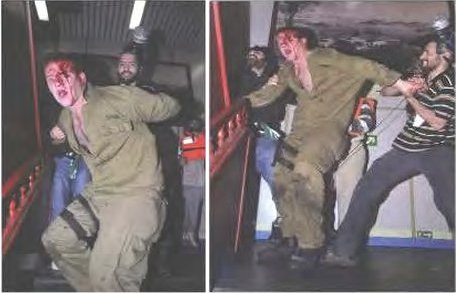
Left: Caption from the book - The soldier who was beaten with iron rods and wooden clubs. His face was bloodied and fear can be seen in his eyes as he is taken below. Right: Caption from the book - After the three well-armed soldiers landed, they were beaten and taken below decks.
“…Sliding down the rope to the deck of the ship we were in the air for two or three minutes. My commander told me to get a stun grenade ready to disperse the people waiting for us on the roof. From the helicopter I could make out about 15 people, some of them wearing gas masks or smoke masks and most of them wearing life jackets [although in the end it turned out they were definitely bulletproof vests].
“…At that point and in accordance with the preparations we had made, as well as briefings and simulations of what we would do, I still thought we would be faced with proportional resistance from peace activists and that at worst we would have to get a little physical, or maybe even use less lethal arms, paint [balls] or Tasers, to restrain them. During briefings, including one-on-one conversations with the commander of my team, it was stressed that firearms were to be used as a last resort and only in case our lives were in immediate danger.
“…The [helicopter] pilot gave the order to lower the first rope from the opposite side of the helicopter and it was let down. I didn’t see what happened next, but in retrospect [I realized that] the operatives on deck caught it and tied it to the ship. Then the second rope was thrown down on my side, and someone tapped me on the back and signaled me to slide down. I thought that when I reached the deck I would have to struggle against a mob of people but that I would be immediately backed up by the other soldiers and that we would overcome them.
“However, from the time I reached the deck until the next soldier arrived eight seconds passed, and that is a very long time for this type of action. While I was still in the air I saw that the 15 people who were on the roof had been joined by dozens of others wearing gas masks and rescue suits, and armed with clubs and iron rods, monkey wrenches and axes. When I was about two or two and a half meter above the deck, they took hold of the rope and dragged it aside.
“Before my feet hit the deck about ten men jumped on me and started beating me with clubs, iron bars, their fists and anything else they could find. They beat my whole body, but they focused especially my head and face. I have to make it clear that at that point I wasn’t armed, my gun was still attached to my back and all I had in my vest was a Taser, which, in view of the brutality of the attack, was not really relevant. That was when I knew my life was really in immediate danger…
“They shoved me toward the hull and because there were so many of them I couldn’t defend myself. A number of them picked me up by my legs and body and threw me down to the lower deck, a distance of about three and a half meters. I couldn’t see any other soldiers on board and so I thought I was the only soldier who had landed. When I hit the lower deck I broke my arm and a mob of dozens of men jumped on me and simply tried to lynch me, that is, they broke my helmet and choked me, drove their fingers into my eyes and tried to gouge them out, pulled my arms and legs one way and then another, and beat me with clubs and iron bars, especially my head.
“I thought I was going to die, it was much worse than what we call a danger to your life. At that point they acted like they were fighting an enemy and had come to kill him, that is, kill me. I kept waiting for the blow to my head that would kill me. At that point the mob tore off my vest, where my gun was, and it fell out.
“I realized that I couldn’t overcome all of them and to save my life I wanted to jump into the water, but in the first place, I was afraid [I wouldn’t fall into the water and] I would just land on a lower deck, and in the second place, the mob didn’t let me get near the hull…
“…Someone hit me in the head with an iron bar. That disoriented me for a second and that was when they took my gun. At that point I thought the mob wanted to take me hostage and use me as a bargaining chip to enter the Gaza Strip. My face was covered with blood from the wounds to my head. The mob kept beating me and shoved me below decks. I realized it was useless to resist physically and that I couldn’t fight them all off and I simply looked for the chance to jump into the water to escape. At that point I was certain I was going to die…
“…Then they took me below decks and kept taking photographs, videos, stills, it was like a press conference. They continued beating me, mostly around the head with clubs. Every time they beat me I thought I was going to pass out, or worse than that, die. All the time I was being shoved along below decks one of them kept choking me from behind and twisted my arms behind my back, and everyone who passed me joined the beating. When I was halfway down the ladder I started saying, ‘Doctor, doctor,’ and they brought a doctor to me. My head had a very deep cut. The doctor ‘treated’ me for the cameras, but all he really did was wipe the blood off my forehead. I had an open skull wound which he didn’t even touch. [Note: When the soldier was hospitalized in Israel, he was diagnosed with a deep skull wound which required 14 stitches and a fractured skull.] After that they took me down to a passenger lounge, laid me out on a couch and one of them kept watch over me, holding a club over my head. I asked for water and felt I had lost so much blood I was going to pass out. At first they wouldn’t bring me water, and they only did after ten or fifteen minutes.
“That was when I saw there were two kinds of people in the room: there were terrorists, very large, strong men, about twenty to forty years old, armed with cold weapons running back and forth like they were in the middle of a operational activity. Some of them were talking on walkie-talkies, reporting about what was going on. Except for the fact that they weren’t wearing uniforms, they looked exactly like a military force. There were also people who were relatively moderate, men and women, a little older who showed restraint and did not harm me.
“I saw that the two groups did not agree with each other. The terrorist group wanted to hurt and kill me, while the others tried to protect me. I was afraid that one of the terrorist group would get to me and either shoot me or stab me to death.
“A short time after I was put below decks two other captured soldiers were brought in. I saw that soldier C had been very badly beaten and was exhausted and barely conscious. Soldier B was brought over to where I was, he was limping but I couldn’t see anything external. However, later I found out that he had been stabbed in the stomach. Each one of us had a guard who held a club over our heads. I want people to know that all the time I was alone below decks, before soldiers B and C were brought in, the mob kept pointing at me and yelling ‘Gilad Shalit,’ and they were very happy that an Israeli soldier had been captured.
“A couple of minutes later soldier C began having convulsions, and I started moving around and yelling that they had to bring a doctor. The guards reacted by beating me and tied my hands. Because of my shouts a doctor came and poured water on C but that was all he did, he didn’t take serious care of him…
“…Later the PA system came on and we could hear the captain saying that the ship had been taken over by the soldiers and that they were using firearms and that all the passengers had to go below decks. The announcement caused a lot of agitation in the ship and people yelled ‘Allahu akbar’ [‘Allah is mighty’] and began inflaming each other’s emotions. After that they moved us [to the upper deck] and sat us near the prow. I saw that soldier C wasn’t walking, that they were dragging him. Two men dragged me as well. At that point I thought they were moving us to the prow to execute us…
“After about ten minutes they opened the door and took us out towards the prow, the man guarding me held me a little less tight and waved his arm back and forth toward one of our boats, and I understood it was to show our forces that they were holding Israeli soldiers. Since he was only holding me with one hand and not very tightly, I elbowed him in the ribs and jumped into the water. The guard tried to hold me but I got away from him and fell into the water. I did it because I knew it was the only way I could save my life…
“…In the hospital they found I had skull fractures, two cranial hemorrhages, a deep cut on my head and many superficial wounds on my face. I also had a hemorrhage in one eye and my left arm was broken.”
Testimony of Soldier B
Pictures of Soldier B – from The Bloodstained Mavi Marmara, by Şefik Dinç
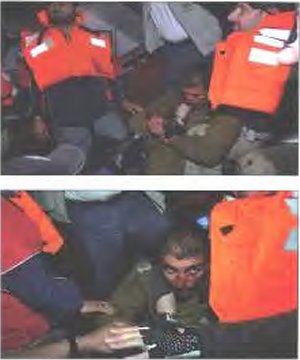
Caption from the book: The soldiers taken captive were surprised when they were taken below decks just as they were surprised by their capture when they landed on the ship. They may have secretly thought they were going to be executed. The intervention of a number of volunteers prevented the IDF soldiers from being beaten more.
“…During the flight [to the site of the Mavi Marmara] I was in direct contact with the pilot and my commander, receiving ongoing updates. At first I was given to understand that there were between ten and fifteen men on the roof. (That was at first, after the helicopter arrived many more came up there…) I received a report that the naval force had met with serious, aggressive violence, and a decision had been made that soldiers would not climb [onto the ship from boats in the water…]. The fleet commander ordered me to prepare two stun grenades. On the port and starboard sides of the ship…we were planning to throw a rope. I saw a large group of men, thirty or forty on the roof, they were wearing rescue suits and gas masks, they were holding chairs…At that point I understood that the resistance to the soldiers being lowered from the helicopter had become physical, to keep us from reaching the ship…I skipped over the soldiers in the helicopter and went down third…As I slid down the rope I saw that there were four times as many people on the roof than there were before and I knew that confronting them was going to be different from what I first thought.
“As I was sliding down the rope I saw that they were throwing things at us. They hit me with iron bars and stones. When I reached the roof I felt a hard blow on my neck from behind, and I saw I was surrounded by about fifteen or twenty men, some of them holding clubs and some of them holding knives, axes. They were all wearing orange life jackets, some of them with kaffiyehs covering their faces and some wearing gas masks and some whose faces weren’t hidden. I immediately understood that my life was in danger and that the lives of the other soldiers who were sliding down from the helicopter were also in danger.
“I knew that as commander I was not in control of the situation…I went flying from a blow. Someone gave me a hard shove and I fell. I found myself sitting on the floor with my back to the hull of the ship and people all around me. They were holding axes, knives, iron bars and clubs and running toward me, it was only going to take a second or two until they reached me…
“…As soon as they reached me they snatched my gun and hit me as hard as they could with the bars and clubs. I was sitting with my back to the hull with my knees bent and protecting my face with my hands. All the people surrounding me were hitting me as hard as they could, especially my head. They were in a frenzy, screaming ‘Allahu akbar’ [‘Allah is great’] over and over. They were hitting me all over, but mostly, as I said, my head.
“After about two minutes when they were beating me and I was trying to defend myself a number of men grabbed my arms and legs and picked me up, and I realized they were going to throw me overboard into the water. I resisted and struggled as hard as I could but it didn’t do any good. I have to say that even then they continued hitting me hard in the stomach. I fought back as hard as I could until they got me over the hull. I hung onto it with both hands and was hanging from it. The people above me kept hitting my hands and the other group on the lower deck dragged me down by my legs.
“Then I fell down onto the lower deck very fast. When I hit the deck some more people rushed over to me because they heard shouts of ‘Allahu akbar.’ I was lying on the deck and many people were standing over me. One of them jumped on me and I felt a sharp pain in my lower abdomen. I put my hand out and felt a knife and knew I had been stabbed. Instinctively I pulled the knife out. I have to make it clear that even then, they were still beating me, even with clubs. Then some of them dragged me [off the deck and] into the ship. All I could think was that they were bringing me into the ship to kill me.
“I tried to resist and to find something to hang onto. Every time I resisted they beat me hard. At first they dragged me inside to a ladder, and before they shoved me down they took all my equipment. I resisted as best I could but without success. I remember they kept screaming, their eyes were insane and full of hate, and I knew it was the end and they were going to kill me.
“They dragged me down a ladder, two men, one above and one below… while they were dragging me by my pants they started coming off and my shirt hiked up. I saw that there was massive bleeding and I could see my intestines spilling out of my stomach. (Today I know it was because I pulled the knife out.) I also saw I had a deep cut on my left arm and it was also bleeding a lot, and I could feel blood running from my nose into my mouth. My head was uncovered because they took my [head cover] after they took my equipment.
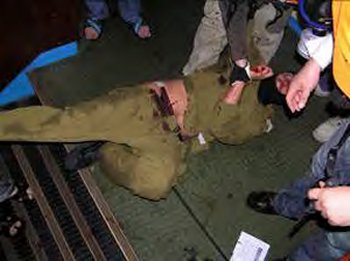
Operatives surrounding the wounded IDF soldier they captured, apparently soldier B. In the lower right-hand corner one of them can be seen holding a knife (hundreds of knives had been prepared as weapons for the confrontation) (Photo by Adem Ozkose for Reuters, May 31, 2010). The soldier was stabbed while he was wounded and helpless.
“While they were dragging me down the ladder I saw soldier C lying on the bottom deck with men acting crazy all around him, they kept beating him without stopping. They kept dragging me down the ladder and my pants kept coming off and my shirt kept hiking up. Then they moved off a little and I found myself surrounded by people with cameras, video and still cameras, and they kept taking pictures, I could see the flashes going off.
“That was when I asked for a doctor and pointed at the cut in my stomach. I received a gauze pad and pressed it on the wound on my stomach…Then I remember two men wearing bandannas made out of green Hamas flags who were really eager to kill us. They tried to strangle me and soldier C, and you could see the hate burning in their eyes. They told us in English that they were going to kill us. Apparently what kept them from doing it was that there were people who wouldn’t let them and pushed them away.
“After that they dragged me to the next lower deck and put me in a lounge. I found soldier A there, his whole face was bloody. They put me on a couch across from him. It was a big lounge with a lot of couches. There were dozens of people there, women with veiled faces took care of wounded men, but not of us. Right after they brought me there they brought soldier C as well and put him on a couch next to me…They tied my hands and feet with rope. There was a man next to me who held a wooden stick in one hand and my hand in the other. He beat me with the stick and with his hand signaled that every time I moved he would hit me hard… Everything began to be blurry, I guess from loss of blood…”
Question: “Did any of the passengers actively try to help you?” Answer: “There were two groups, one which tried to kill us and was only waiting for the chance. The other tried to defuse the situation and they were the ones who kept the extremist group from killing us.”
Testimony of Soldier C
Pictures of Soldier C – from The Bloodstained Mavi Marmara, by Şefik Dinç
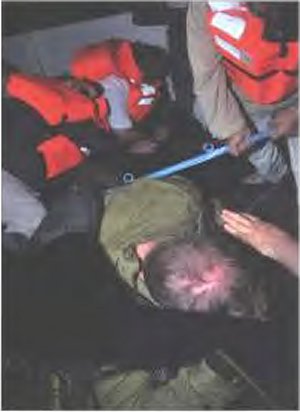
Caption from the book: The soldiers who slid down ropes met with resistance from the passengers. The three first soldiers were captured and beaten with iron bars and wooden clubs and taken to the space below the captain's bridge.
“…At a certain point we received instructions that the helicopter would lower the force onto the roof with ropes. One of the soldiers sat near the door and saw a number of men on the roof…When I reached the deck I saw a terrorist with an iron crowbar waiting to hit me over the head, but when he tried to I shoved him away and four more terrorists jumped me straightaway. One of them wrapped a chain around my neck to choke me while I was trying to fight them off…
“At that point I lost consciousness, I saw stars, I imagine from being strangled. When I regained consciousness I felt I was in the air. Three or four terrorists were throwing me from the upper deck to the bridge deck. I felt heavy and I could tell I was falling fast and hard. About twenty men with clubs, axes and other weapons were waiting for me on the lower deck. As soon as I fell, and it seemed to me they had it all planned, they caught me and dragged me into the ship. I saw knives and they cut all my equipment away and they kept beating me all the time…Then they dragged us, I was barely conscious, they dragged us down a ladder into the ship…
“…They put me in a room [i.e., lounge] and kept beating me. The room was full of blue couches and they put me on one of them. There were two men, one of them kept hitting me all the time I was tied to the couch and they also held me down while he hit me. There was another guy there, he tried to calm him down, but it didn’t do any good. Things began to get fuzzy and I didn’t feel well, I could feel my head…That was when I lost consciousness. (My comrades told me I had convulsions as well.) The next thing I remember was waking up with the commander of the medial unit over me taking care of me, and then I lost consciousness again. The next time I woke up I was in the hospital…”
Question: “How did the organization of the operatives strike you?” Answer: “As I said before, it looked like it was premeditated, when they threw me from one deck to another there were people waiting there who knew what they were supposed to do with me, to take my equipment and undress me and from there to put me in an inner room, and all the other operatives took them [i.e., the other captured IDF soldiers] to the same room, it had to be organized.”
Question: “How did the operatives look?” Answer: “They were all wearing the same thing, gas masks and orange vests. They seemed to be well prepared, they waited and it was as though everything had been planned. They were all big, heavy men and their objective seemed to be very clear, to harm us.”
Question: “Were all the operatives the same?” Answer: “It seems to me that there was a group with a lot of equipment, and that was the group that came after us. All the time they were dragging me inside they were taking pictures, and I heard women’s voices in English saying ‘Stop hitting him’ and other things.”
Question: “Describe your wound and recuperation.” Answer: “I was taken to the hospital unconscious and breathing with a respirator. My skull was fractured and bleeding internally. They sent me straight to the operating room. They fixed my skull, they put the pieces back in place, I had an open skull wound and I was lucky my brain was not damaged.”
Question: “While the helicopter was approaching the ship did you or anyone one else fire a weapon before you descended to the ship? Answer: “No. The only thing we did was throw stun grenades to disperse the terrorists at the point of descent. Beyond that, we didn’t fire at all [from the helicopter]. No firearms were used.”
Notes:
[1] The testimonies of the soldiers corroborate the description of the events in The Bloodstained Mavi Marmara by Turkish journalist Şefik Dinç’s, who as aboard the Mavi Marmara. He wrote that the intervention of a number of activists prevented the IDF captives from being beaten even more. He said that the doctors among the passengers also tried to prevent the soldiers from being beaten.
[2] Şefik Dinç documented their capture. For the pictures, see the Appendix.
[3] The testimonies of the soldiers corroborate the description of the events in The Bloodstained Mavi Marmara and Şefik Dinç’s interview on Israel’s Channel 1 TV. He said the Israeli soldiers untied the hands of the several passengers, especially older passengers, women, and men who had not created a disturbance.
[4] The testimonies corroborate the description of the events in The Bloodstained Mavi Marmara. According to the book, the operatives on board were prepared for every scenario, and expressed their readiness to die (pp. 23-24). According to ITIC information, before the violent confrontation seven of the nine operatives killed had stated, in one way or another, that they intended to die as shaheeds.



 RSS
RSS

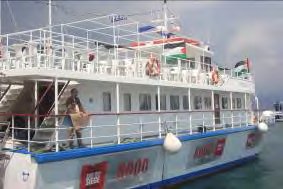

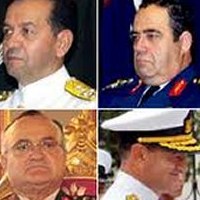
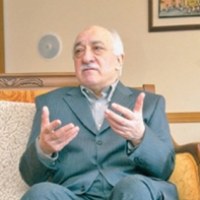
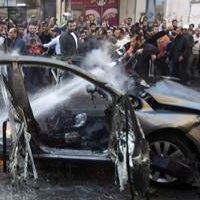





Testimonies from #IDF #Naval #Commandos Who Participated in the Raid on the #Mavi #Marmara | #Israel #jcot #Gaza #Turkey http://j.mp/fe6zLQ